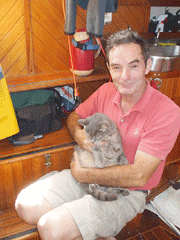Way Downstream
Annapolitan Bob Williams spent the summer of 2007 sailing north in search of an iceberg and to spread the news on global warming [www.bayweekly.com/year07/issuexv44/leadxv44_2.html]. On June 2 of this year, he set sail again — this time to reach his goal of burying on Greenland a time capsule he expects to be released by global warming. With his only crew a cat, whom he calls Bob Cat, Captain Bob has reached St. Johns, Newfoundland, according to his online blog, updated daily. You can read about the Bobs’ day-to-day adventures, including thoughts from the perspective of Bob Cat: “Some seek adventure; others, like me, have it thrust upon them,” (June 16, 2008). Read on at http://blog.mailasail.com/sylph …
[www.bayweekly.com/year07/issuexv44/leadxv44_2.html]. On June 2 of this year, he set sail again — this time to reach his goal of burying on Greenland a time capsule he expects to be released by global warming. With his only crew a cat, whom he calls Bob Cat, Captain Bob has reached St. Johns, Newfoundland, according to his online blog, updated daily. You can read about the Bobs’ day-to-day adventures, including thoughts from the perspective of Bob Cat: “Some seek adventure; others, like me, have it thrust upon them,” (June 16, 2008). Read on at http://blog.mailasail.com/sylph …
Like a phoenix, a lighthouse has risen from its ashes. Blackistone Lighthouse was a beacon on St. Clement’s Island from 1851 until destroyed by fire in 1956. On June 22, the lighthouse opened again, restored to original specifications and with original materials. The work was supported by over half a million dollars from state and federal governments, and from the Blackistone Lighthouse Foundation, Optimist Club of the Seventh District, St. Clement’s Hundred, St. Mary’s County Historical Society and more. The historic lighthouse stands on the island where the Ark and the Dove arrived from Cowes, England, in 1634 and voyagers set foot in a new colony, called Maryland …
Nature’s a game this summer, at least for kids. Families will find the 2008 Maryland Bay Game, an annual activity book produced and distributed by the Department of Natural Resources, at visitor’s centers and libraries. Young naturalists better endure long car trips while reading interesting facts and completing puzzles on watersheds, wildlife, forests, geology and agriculture. In April, Gov. Martin O’Malley signed an Executive Order establishing the Maryland Partnership for Children in Nature, a coalition to invigorate environmental learning. Pick up your Bay Game, or download it at www.dnr.maryland.gov/baygame.

The novel extinct dolphin species unearthed near Calvert Cliffs has been named after Jean Hooper, the Calvert Marine Museum paleo-volunteer who discovered the remains. The name — Stenasodelphis russellae — honors Hooper by using her maiden name, Russell, as the basis of the species name. The new genus name (Stenasodelphis) comes from Latin word Stena, or the narrows, a reference to the bones; naso from the Latin nasus for nose, a reference to the nasal bones appearing to be pinched; and delphis, Greek for dolphin. Hooper found the partial skull of the extinct dolphin and helped determine that it was an unknown species …

Our Creature Feature is good news for a rare bird. The population of endangered whooping crane numbers has reached 500, the most wild and captive-bred whoopers we’ve had at one time since the 19th century. In 1945, the flock was down to just 15 birds; in 1971, whooping cranes were declared an endangered species.
In the only remaining wild flock on the continent, some 266 cranes wintered along the Texas Gulf Coast, which includes Aransas National Wildlife Refuge. By mid-April, 87 percent of the flock begins migrating to its summer home in Canada. Elsewhere, five whooping crane breeding facilities — including Patuxent Research Refuge in Laurel — raised eggs or chicks in 2007. Young birds are then led to Florida by ultralight planes.
The tallest bird in North America, whoopers are also among the rarest. Find out more at www.operationmigration.org.